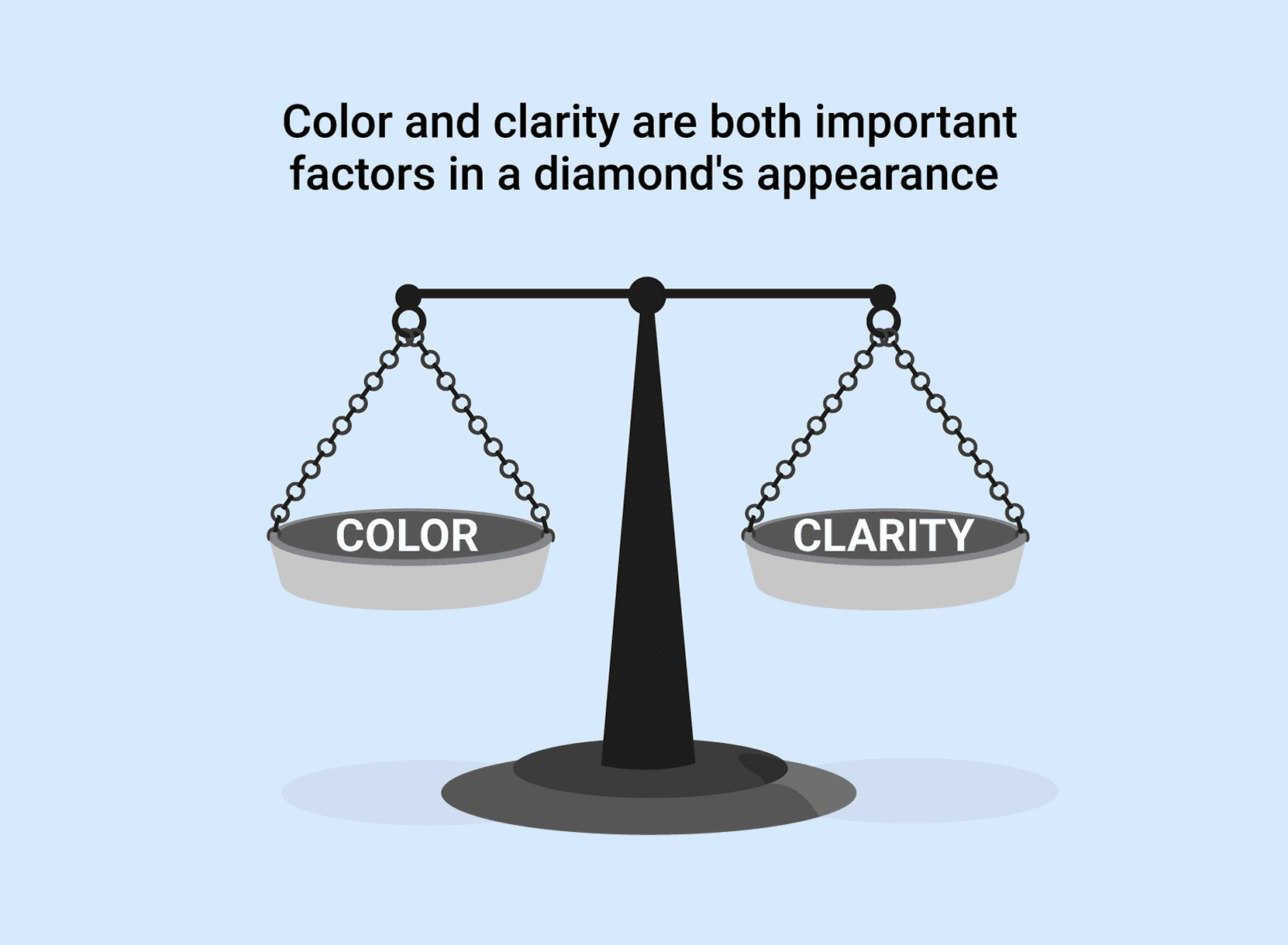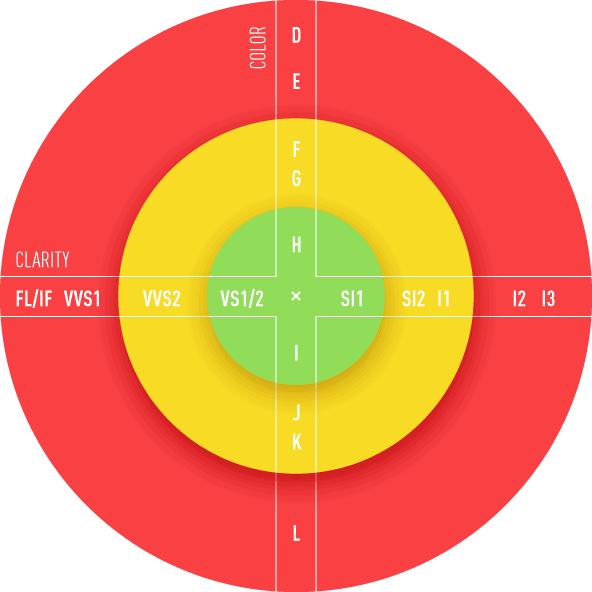Diamond Color vs Clarity: Which Is More Important?
How to balance color and clarity to get the best diamond possible
How to balance color and clarity to get the best diamond possible
When choosing a diamond, the debate often centers around color versus clarity. Both significantly influence a diamond’s appearance, but which holds more weight? In essence, neither is universally ‘more important.’ It’s about striking the right balance for your preferences and budget. While color refers to the diamond’s tint, clarity assesses imperfections. For most, the goal is to select a diamond that appears white and is free of visible inclusions, ensuring both beauty and value.
In this article we discuss both diamond color and clarity and how to find the perfect balance for the perfect diamond.

If you’ve searched online for information about buying a diamond engagement ring or any other type of diamond jewelry, you’ve almost definitely seen color and clarity mentioned as two of the most important characteristics that you should keep in mind as a customer.
Color and clarity both affect a diamond’s appearance, often significantly. A diamond with a poor clarity grade will often have blemishes and inclusions that are visible to the naked eye, making it far less elegant and beautiful.
A diamond with a poor color grade will often have a visible yellow tint, which can also affect its appearance. Combine a poor clarity grade with a poor color grade and you can end up with an unattractive, aesthetically subpar diamond such as this one from James Allen.
As we’ve explained in our diamond buying guides, getting the best deal on a diamond is about focusing on the factors that have the biggest impact on its appearance while spending less on those that have little, if any, effect.
Below, we’ve explained how color and clarity fit into this, as well as which of these two factors you should prioritize when shopping for diamonds.
How diamond clarity affects the appearance
How diamond color affects the appearance
Diamond color and clarity chart
FAQs about diamond color vs clarity
Bottom line recommendation
Why you should trust us
Before getting into the specifics of diamond color vs. clarity, it’s important to explain the basics of how color and clarity actually affect a diamond’s appearance.
As we’ve covered in our guide to diamond clarity, diamonds are graded for clarity on a scale that runs from IF (internally flawless) to I (included). The higher the grade, the clearer the diamond, with fewer inclusions and a cleaner, more perfect appearance.
One of the most common mistakes people make when purchasing a diamond is overpaying for clarity.
Instead of overpaying for flawless clarity, it’s much better to choose a diamond that’s eye-clean, meaning it doesn’t have any inclusions that are visible to the naked eye. Then, you can assign more of your budget to other factors that affect the diamond’s appearance.
For example, compare this 1.05 carat VS1 clarity diamond from Blue Nile to an IF clarity diamond of the same cut, color and carat weight. Both diamonds are eye clean and will look almost identical in a ring, but the IF clarity diamond costs $1,155, or 31 percent, more than the VS1 diamond.
By not spending the extra $1,155 on unnoticeable extra clarity, you’ll instead be able to spend it on a better color grade or a larger diamond.
In short, it’s generally not worth paying for something you’ll never notice. When it comes to the clarity of a diamond, your goal should generally be to choose the most affordable diamond (at least from the perspective of clarity) that’s eye-clean.
Diamonds are graded for color using a scale that runs from D (colorless) to Z (noticeable yellow or brown color). Most diamonds used for jewelry are between D and M on the scale, with lower grade diamonds typically reserved for industrial use.
GIA, the worlds leading diamond certification laboratory, grades as such: “A chemically pure and structurally perfect diamond has no hue, like a drop of pure water, and consequently, a higher value. GIA’s D-to-Z diamond color grading system measures the degree of colorlessness by comparing a stone under controlled lighting and precise viewing conditions to masterstones of established color value.”
When it comes to color, the closer a diamond is to the D end of the scale, the less likely it is to display a visible yellow or brown tint. We’ve explained diamond color grading in more detail in our diamond color guide.
While the color of a diamond matters to a certain point, it’s most important to choose a diamond that looks colorless in relation to its setting.
Just like with clarity, a common diamond buying mistake is to overpay for a diamond with a very good color grade, such as a D, E or F grade diamond. Often, diamonds in this area of the color scale look virtually identical to those in the G, H or I range, despite costing significantly more.
For example, compare this 1.00 carat G color diamond from James Allen to this D color diamond of the same cut, clarity and carat weight. Even under magnification and bright studio lighting, the color difference between the two diamonds is very small and difficult to notice.
Despite their very similar appearance, there’s a difference in price of $1,190 between these two diamonds.
Different diamond shapes display color differently. For example, a round brilliant cut diamond will generally be good at concealing color, whereas an emerald cut diamond, which has straight facets, will display any internal color more obviously.
This diamond clarity and color chart shows you where your sweet spot is when buying a diamond. Diamond clarity and color are both important factors in a diamond’s appearance. Both have an impact on a diamond’s appearance, and both are features that you’ll need to pay attention to if you’re shopping for a diamond.
However, they’re not the only factors that determine how a diamond will look, or the first factors that you should look at when comparing diamonds.

If you’ve read other content on our website, you’re probably aware of the 4 Cs of diamonds — cut, color, clarity and carat weight. These four factors play the largest roles in determining how a diamond looks, as well as how much it will typically cost.
Buying a diamond is all about striking the right balance between the factors that affect the way it looks and those that have a minimal impact.
One way to think of clarity and color is as “negative features.” Color and inclusions are features that you don’t want to see in a diamond. As long as these features aren’t visible, a diamond will look beautiful and impressive, provided it’s cut well.
Cut quality and carat weight, on the other hand, are “positive features.” You want to maximize them as much as possible.
Of the four Cs, we recommend starting with cut quality. After you’ve limited your search to ideal or excellent cut diamonds, you can move on to clarity by checking which clarity grade brings up diamonds that are eye-clean.
Once you’ve found the right clarity grade, then you can focus on color. Once you’ve identified a color grade that appears colorless in relation to your setting type, then you can put as much of your budget as possible towards the carat weight.
If you’re shopping for a diamond online, you can follow the steps below to make this process easier:
If you need help, feel free to contact us for personalized advice and assistance. Our expert team can help you choose a diamond engagement ring based on your budget, taste and a wide range of other factors.
The highest-quality diamonds (in terms of clarity) are Flawless (FL) diamonds. These diamonds have no internal or external imperfections, even if viewed under intense magnification with specialized equipment. In terms of color, the highest quality diamonds are graded D, meaning they are completely colorless.
The lowest grades for color and clarity are Z (for color) and I3 (for clarity). Z color diamonds are noticeably yellow, while I3 clarity diamonds have clear imperfections, easy to spot with the naked eye.
If you’re on a budget, look for diamonds between VS2-SI1 clarity and H-J color. In this range, most diamonds appear colorless and free from imperfections under normal viewing conditions. This will save you a significant amount of money compared to higher grades, with little noticeable difference in the quality of the diamond.
Color and clarity are equally as important when shopping for a diamond. You want to find a sweet spot where the diamond appears both eye-clean and colorless under normal viewing conditions. Though certain shapes or settings make clarity or color more important, in general, you need to consider both.
When buying a diamond, it’s important to consider both color and clarity. Both have an impact on a diamond’s appearance, although they’re not the only features you should look for. But you need to make sure you find the right balance.
If Goldilocks had $10,000 to buy a diamond and she was hyperfocused on getting the best possible color and clarity, she would end up with this beautiful diamond that is too little (given her budget).
If Goldilocks would ignore the color and clarity completely, she would end up with a diamond that may be big like this one from James Allen, but looks horrible. But if she finds the right combination she will find this stunning diamond from James Allen that is just right.
We recommend that you start by checking that the diamond is eye-clean, meaning it has good enough clarity that there are no visible inclusions to the naked eye. Then, check that there’s no visible yellow tint to the diamond.
Beyond a certain point, paying for a flawless clarity or color grade just isn’t necessary and won’t have a major impact on a diamond’s appearance. At this point, it’s better to focus on cut quality and carat weight, both of which are much more visible.
For more information, you can read our full guides to diamond color and diamond clarity, or contact us for personal help finding the right diamond.




Before you buy a diamond, get personal buying advice from industry veterans. We'll help you get the best diamond for the money.
DISCLAIMER: We don't use your email for marketing. Period.
A diamonds’ price is determined primarily by the 4 Cs of the diamond. On the wholesale level, diamond prices are first based on a diamond shape and
Buying an engagement ring is often one of the first major purchases in a person's life. The process can be fraught with tension as there are so m
A wide range of 1 carat diamonds exist both in online markets and local diamond jewelry stores. Not only are there significant differences in beauty
Please enter your email address to receive your 25% off coupon code:
Here is your coupon code: GFDSF3GF